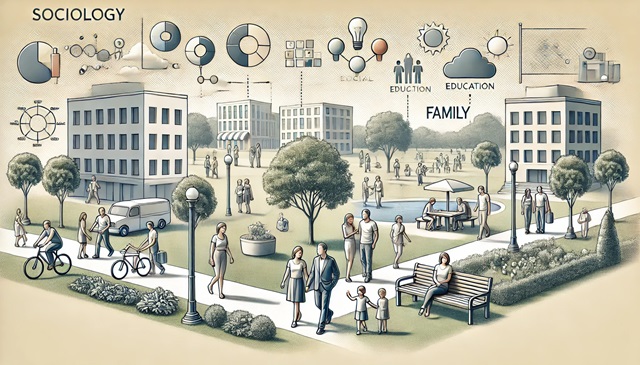At a Glance
We have looked at what conflict is, as well as the tremendous cost and consequences it brings to the workplace. There are so many costs associated with a negative conflict that it can cause a business to implode upon itself.
In this article, we will look at how you can resolve any conflict. The conflicts most likely to be resolved are going to be horizontal conflicts -- that is, conflicts between two or more people or groups who are generally of the same level on the organizational chart.
Who is right and who is wrong
The concepts you learn in this article are meant to be applied to horizontally-oriented conflicts. They will work for vertical conflict, as well as outward conflict, but you need to know that there are additional factors at work when that happens.
With horizontal conflicts, you can usually apply the principles in this article to find a mutual ground to work from. However, when there are conflicts between a superior and subordinate, (a vertical conflict), or between a company and its vendor or customer, (an outward conflict), you need to be aware that there may be greater things at stake.
In a vertical conflict scenario, the subordinate may not have the full picture in mind during the conflict and thus a middle ground isn't reached:The employee simply has to be told that their opinions are only representing a small portion of a major organization. For example, conflict that springs up from a single employee who wants a huge raise. The employee is only considering his or her own financial well-being, and not considering the overall well-being of the company. In this case, the subordinate and supervisor will not be able to go through all the steps in this article, because the reality is, the employee is in the wrong, and they will not get the raise they feel they deserve. (Granted, some vertical conflicts start from other situations that can be resolved using the tactics you will learn in this article, but often those conflicts are related to personality conflicts or misunderstandings about a job function, rather than to specific business conflicts).
In an outward conflict scenario, quite the opposite is often going to be the case. Even if the customer or vendor is in the wrong, it could be in the business' long term interest to simply give the customer or vendor what they want, rather than to bring in a mediator to solve the problem. One example might be if a customer makes an unreasonable request. The company could fight the request, or they could weigh the cost of fulfilling the request versus the cost of keeping the customer as a long-term customer. Sometimes it is worth the expense of fulfilling the request. Of course, there are times when the strategies you are about to learn about can come into play with customers and vendors, but often these have to do (again) with personality conflicts, or expectations, rather than specific requests.
So, before you apply this conflict resolution step-by-step guide, you need to use some personal judiciousness to determine whether it is completely necessary. If someone is clearly in the wrong, (like the employee mentioned above), it might not be appropriate to use this conflict resolution system. If someone is clearly in the wrong but they are a customer or vendor, and you want to meet their demands, it might not be appropriate to use this conflict resolution system.
A basic structure
Here is the basic structure of a conflict resolution. In a moment, we will look at each individual point in greater detail.
1. Define each person's starting point.
2. Define each person's ultimate goal.
3. Define each person's areas of concession.
4. Find common points.
5. Define a middle ground.
6. Are both happy?
7. Create an agreement.
8. Review with accountability.
As we go through the conflict resolution in greater detail, please note that we are treating it as if you are attempting to quell a conflict that you are not a part of -- that is, you are a neutral observer, (like a colleague or a supervisor). However, this system can be used if you are closely involved in the conflict. Just be aware that it may be more difficult to appear unbiased and have the other party listen to you. In spite of this, sometimes the only choice is a clear head from one party standing up and starting the process of conflict resolution. If that is you, you have a tough challenge ahead of you, but it is not impossible.
Define each party's starting point.
When we say each party's starting point, this includes all parties in the conflict as well as yourself.You need to be aware and be up front about the influence the conflict has on you, as well as the affect the final outcome will have on you. Aside from knowing this information yourself (to help you achieve neutrality in the mediation), it will also help you appear to be transparent with each part. That transparency will win you respect, which is something you will need in order to help the parties reach a middle ground.
How do you define each party's starting point? You will need to interview each party and ask them:
What was the task that you were assigned to do?
What do you see as the cause of the conflict?
What are the main points of the conflict as you see them? (Specifically, what is "your side" of the conflict?)
What is the other party asking for?
What are the main issues of contention in the conflict?
The answers to these questions are going to help you determine where each party is at. It will help you to reveal where the parties are starting from, since many conflicts can arise by simply misunderstanding the purpose of the project.
Real life example: An accounting department and the front-line staff of a large corporation became embroiled in a conflict. It became very intense and didn't appear to be easily resolved, so a supervisor was called in to mediate. It was determined that the accounting department had been given a mandate to vigorously implement rigid accounting practices, which they were doing a very good job of implementing. Unfortunately, the front-line staff had been given so much additional paperwork, they were unable to do their real job of selling products to customers. The supervisor pointed out to the accounting department that, although they had to implement good accounting procedures, they were ultimately there to enable the front-line staff to sell more products. Because, without the sale of products, no one would have a job. A middle ground was developed by hiring an extra person in accounting to do some of the paperwork that the sales staff were unable to do. With their renewed focus on sales, the income generated more than made up for the additional employee's wages.
The company depicted in the example above had a conflict in which one of the parties misunderstood their mandate. Although they needed to implement accounting practices, they could not do so at the cost of customers, or else there would be no company at all. Good accounting practices are necessary, and they were able to find a way to implement them, but the front-line staff needed to be freed up to do their job so that everyone could have a job to go to! The mediator uncovered this problem early on by simply discovering the starting point of each party and learning that the accounting department had a different starting point.
Define each person's ultimate goal.
While you interview each party to determine their starting point, you should also ask them to tell you about their ultimate goal. Although this can happen in the same interview as the previous section, it does not have to, and we have included it here as a separate point because of how important it is. This is where you may uncover other problems that exist - and even opportunities that can allow you to find resolution.
Again, this needs to be done separately, and have each party simply describe to you what the finished product, or completely resolved situation, will look like.
Encourage them to talk about the resolution from their perspective as if it were fully resolved, with only their desires coming true. This will help you to uncover any unrealistic ideas they may have, as well a potential common ground.
Real life example: Mediators in wage disputes between unions and management will do this early on in negotiations: They will ask each party what their ideal result would look like. The union might want to see a $2 per hour raise for each employee. Management, on the other hand, might envision no raises whatsoever.
Do not assume anything! Make sure you interview each party equally, and get their viewpoint on this topic. If you skip this step with some of the parties, you could be accused of favoritism. If you skip this step with all of the parties, you could be guilty of completely missing the point and not actually finding a resolution.
If the conflict involves two or more groups, and you have the time, visit everyone in the group individually, if practical. Sometimes you may find that people are "going along for the ride" because they like the idea of the outcome, although they have very little say in the conflict itself. However, their presence in one party makes the conflict seem worse than it is.
Real life example: In a conflict between two groups of people, each group was trying to convince the other of a new direction the company needed to take. When a mediator was called in, she interviewed each member separately and discovered that the smaller group of people preferred one direction, while the larger group was far more vocal, but also had several supporters who were simply there because of peer pressure. When the mediator interviewed each person, she discovered that there were a few who felt the business should go one way and a few who felt the business should go the other, and many who were ambivalent. She only discovered this, though, by interviewing everyone and discovering what their ideal outcome would be.
The picture of an ideal outcome is a valuable part of getting a project done. If people see that picture differently, they will work in separate directions to achieve it, and there will be conflict as a result.
Define each person's areas of concession.
By now, you should have an idea of where each group started from and where they intend to go. Now it's time to start doing the real work of a mediator. Once again, this step needs to be done individually - with each party not in the presence of the other.
Interview each party and ask them.
In what areas are you willing to concede?
What changes to your ideal goal can you live with?
How different can the ultimate goal be while you are still satisfied with the outcome?
This is where it can get difficult. Some parties don't want to concede too much. Other parties don't want to concede at all. To overcome this barrier, you need to be creative. Try asking questions like:
What would you like to see the other party concede?
What would you be willing to let the other party have of their demands?
Could you live with scrapping this project altogether?
How much of your own position are you willing to give up in exchange for getting something else?
How much of your own position are you willing to give up in exchange for seeing the other party give something up?
At this point, you need to be very careful of something else as well: Depending how long the conflict has gone on, the parties involved may have completely moved off of the actual conflict and have become engaged in bitter rivalries and personal vendettas. You will notice this especially when you ask some of the last questions. When both groups, for example, are willing to scrap the project altogether, or when a group is willing to give up part of its position in order to see another group give up part of its position, you know you are dealing with personal animosity and not the actual conflict.
If that happens, it is best to escalate the situation to upper management. This conflict has gone beyond the bounds of professional conflicts that arise all the time. Instead, this conflict has become personal, and there may have to be Human Resources involvement in order to find resolution.
However, if the conflict has not gotten too personal, you should find that most groups will have some point of concession they are willing to give up. After all, many of us simply go to work to earn a paycheck, and at the end of the day we just want to go home to our families. If you find parties who do not want to concede anything, remind them of this.
If they are still unwilling to concede, ask them what would happen if the other party's ideal goal was eventually implemented and none of their own was put into place. There may be all kinds of talk resulting from this, but you may be able to start them moving on a concession.
Remember, be creative. Sometimes, parties simply need to have an outside view make other recommendations, because they have become so caught up in the conflict that they cannot see the obvious resolution themselves.
Real life example: One company had an internal printing department to meet its printing demands. New procedures were put in place and all departments were then supposed to compare prices on printing at third-party providers, as well as the internal department. The result was that the printing department and the accounting department became involved in a conflict over profitability expectations. The mediator found that the conflict was becoming problematic, with each side not willing to concede: The accounting department was demanding that third-party providers be consulted, while the printing department was frustrated at the loss of work. The mediator made a simple suggestion: The internal printing department should be allowed to take on external printing jobs from other companies. Thus, they were able to increase their workload, and the accounting department was happy with maintaining their third-party procedures. Unfortunately, it took a mediator to see a way through the mess.
The mediator got creative to introduce a new concept to the parties in the conflict, who were wrapped in the details of their own positions. The mediator was able to find a happy common ground for both of them by simply coming up with a new idea.
Creativity is the key. Perhaps you need to enlist the services of another department or another company in order to find an equitable solution. Maybe you need to gather a small group of people together (preferably people who are not directly connected with the conflict itself), and ask them for ideas. You may be surprised at what you hear.
Real life example: The accounts receivable department and the marketing communication department of a small company shared a fairly expensive printer, and often required it on the same day each month. Conflicts arose over its use. Unfortunately, money was not available in the budget to lease another printer; it simply wasn't practical. Scheduled usage times were tried and failed. The departments tried changing the days they needed the printer and that didn't work either. They tried outsourcing some of the printing, but that proved to be too expensive. Then the mediator found an equitable solution: Both parties fought over the printer during the eight-hour workday. During the 16 hours that the office was not open, it lay dormant. The first suggestion was to develop a print queue program that would allow the computer to operate during the evening and nighttime. However, the possibility of debilitating paper jams made that suggestion unworkable. Then the mediator made the suggestion, (in conjunction with the Human Resources Department), to alternate the workday for the marketing department and accounts receivable department. The accounts receivable department would work from 7 a.m. to 3 p.m., Monday through Friday, while the marketing department would work from 10 a.m. to 6 p.m., Tuesday through Saturday. The solution fit with the company's business strategy, no additional money was spent (because no one worked more hours than they did before), and both parties helped to develop the new schedule so they were happy with it.
Find common points.
Sometimes the concessions that each party makes are not enough to completely erase the conflict. In a perfect world, one party would concede half and the other party would concede half and they'd meet in the middle.
The reality is that one party will concede a quarter, and the other party will concede a third, and there's still plenty of space in the middle for conflict to continue.
When this happens, (or when no one is willing to concede anything and you've tried everything you can from the previous section), it's time to find some common points.
To find common points, sit down on your own and look at the big list you've made of the starting points between each party, the ultimate goal of each party, and the points they are willing to concede. At some point you will probably find some common points. After all, conflict rarely starts because people's ideas are completely different. it usually starts because people's ideas are slightly different and those slight differences grow and grow.
In most cases, when two parties' ideas are completely different, the easy resolution is for each party to pursue their own idea. In that case, the ideas are different enough that they won't conflict with each other.
So, you're fortunate that the ideas are only slightly different, because that means you are almost guaranteed to have common points.
In your own study of the problem, highlight all of the common points, no matter how trivial they seem. Also, be sure to highlight things that the parties have done that are similar, even if they are not exactly the same. For example, if one party conceded a quarter of their position, and the other party conceded a third of their position, highlight the fact that each party conceded something.
Even though you have done this exercise on your own, do not yet invite the group back together. That will come, but you don't want to "tip your hand" too soon. Keep them separated so you can make your analysis of the situation.
Define a middle ground.
This is the stage that you bring them back together. But don't do it just yet. Before you bring them back together, define the part that is still not completely resolved. If you have not yet been able to get both parties to concede, and you have not yet found a creative solution, then this will be your most challenging piece yet.
Sometimes conflicts cannot be fully resolved and there will be a middle ground that is not complete. If that's the case, you may have to create a happy medium yourself. (Some mediators are given this authority by the companies for which they are mediating). For example, if one party is asking for a wage increase of $10 and has conceded to $8, and the other party only wants a wage increase of $2 and has conceded to $4, you may have to use your own authority (if given) to say that there should be a wage increase of $6.
Fortunately, though, if you follow the steps outlined so far, you should be able to navigate most conflicts and help each party to creatively develop a middle ground they are happy with.
Now bring both parties back together. Briefly talk about where they are each starting from, talk about the picture each of them have in mind for the completed outcome. Highlight any concessions they have made. Most importantly, spend the most of your time describing the similarities and common points they have made. After you have done that, outline the middle ground and emphasize that each group is working together to make it happen.
Are both happy?
Before you can continue, you have to make sure that both are happy with the resolution. You may have found the perfect middle ground but sometimes some parties may not feel that their side was properly represented in the resolution.
If this happens, it may suggest.
There are unresolved issues you have yet to uncover.
The conflict has moved out of the business stage into personal animosity.
The middle ground you developed was unintentionally biased.
There are aspects of the middle ground you did not consider.
Real life example: A mediator presented a seemingly equitable solution to two departments in a conflict-ridden office. Both parties, on their own, had agreed to the concessions. However, once they were presented in a group, one party vehemently fought the resolution. The reason? The resources that were to be used to help develop the equitable solution were going to be billed entirely out of one department's budget. thereby increasing the cost to that department. The mediator was able to arrange a cost sharing scenario between both departments and the conflict was resolved shortly after that.
Create an agreement.
This is an area that is frequently missed during the conflict resolution process. It involves creating an agreement between all parties to fulfill their end of the bargain, and to agree to the terms outlined.
It's missed because conflict resolution feels like it has ended at the previous stage: If everyone is able to come away feeling happy (or at least somewhat happy) with the concessions agreed to, then an amateur mediator may feel that their work is done. However, conflict can still rear its ugly head because even the conceded middle ground is still open to interpretation by our world views.
To resolve this, and to help keep conflict at bay, an agreement is necessary to help both parties maintain their sides of the bargain.
An agreement should:
Be detailed.
Be quantified. (That is, avoid generalizations. Instead say: "Group 1 will use the photocopier between 3 p.m. and 5 p.m., for example).
Be formal, but not necessarily full of legalize.
Carry consequences if a party does not fulfill its end of the bargain.
Be signed by everyone to acknowledge agreement.
Include a future review/accountability process.
Review with accountability.
Once an agreement has been reached, the mediator should build in some accountability. This should be included right in the agreement, and then scheduled immediately after the agreement has been signed.
This accountability should probably take the place of at least one review at the end of the task (if it is a task that has an end), or several reviews at regular periods through the process (if it is a task that will take a long time, or if it is an ongoing task.)
For example:
If a couple of people are in conflict because they are disagreeing on who can use a meeting room on a certain day of the week, a simple, single review process may work best at the end of the situation.
If two departments are disagreeing on how to implement a new computer system over the next six months, the mediator might implement a review process at two months, four months, and when the finished project is complete, after six months.
If several front-line staff are in conflict about how to implement several business practices, this might be a situation where the mediator has to schedule a review every 3 to 6 months on an ongoing basis, because doing business is not a task that ends.
Although it's not always necessary, it is probably good for the mediator to be the one doing the review. especially if the mediator is a neutral third party. If the mediator is one of the people involved in the conflict, it may be good to have someone else - a neutral third party or a supervisor - perform the review process.
If you are a mediator and you are a neutral third party, you should try to be the one to do the review. There are two reasons for this:
1. In helping the parties find a solution, you have built up some credibility with them, and are thus able to portray the authority necessary to ensure the project is back on track, or to administer the consequences if one party is not holding up their end of the bargain.
2. You will gain valuable insight in seeing how your conflict resolution skills are developing. You will be able to identify areas where you could improve your own skills, as well as strengths you can leverage.
As you help other people resolve their conflicts, you will also gain insight into your own conflict resolution abilities.
Summary
The conflict resolution process is as follows:
1. Define each person's starting point.
2. Define each person's ultimate goal.
3. Define each person's areas of concession.
4. Find common points.
5. Define a middle ground.
6. Are both happy?
7. Create an agreement.
8. Review with accountability.
Each step of the process is vital to ensuring that the conflict is dealt with adequately and followed up appropriately.

































